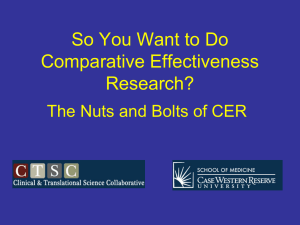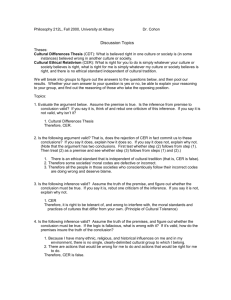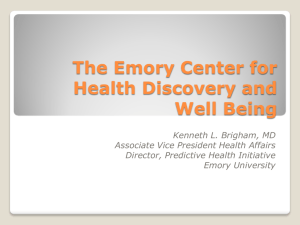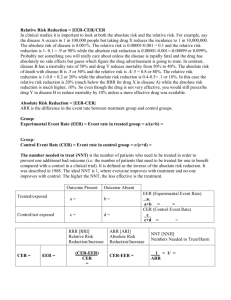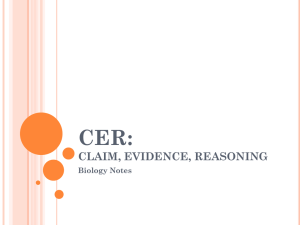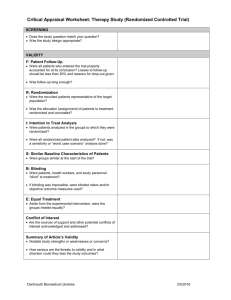A Unique Role for Academic Health Centers
advertisement
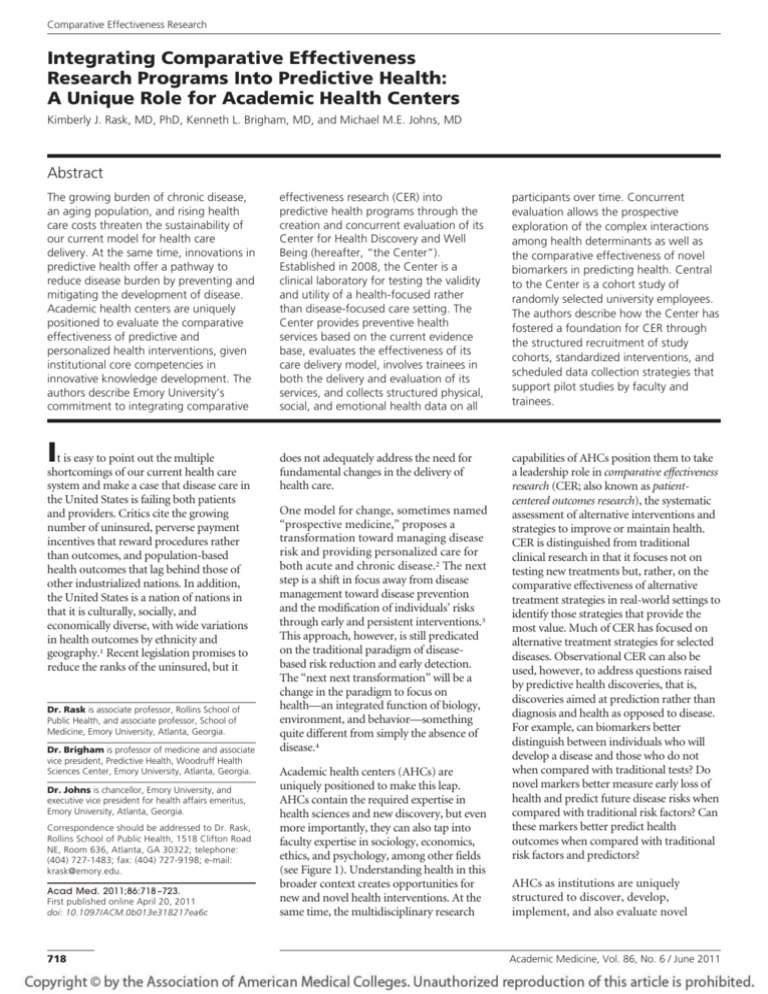
Comparative Effectiveness Research Integrating Comparative Effectiveness Research Programs Into Predictive Health: A Unique Role for Academic Health Centers Kimberly J. Rask, MD, PhD, Kenneth L. Brigham, MD, and Michael M.E. Johns, MD Abstract The growing burden of chronic disease, an aging population, and rising health care costs threaten the sustainability of our current model for health care delivery. At the same time, innovations in predictive health offer a pathway to reduce disease burden by preventing and mitigating the development of disease. Academic health centers are uniquely positioned to evaluate the comparative effectiveness of predictive and personalized health interventions, given institutional core competencies in innovative knowledge development. The authors describe Emory University’s commitment to integrating comparative I t is easy to point out the multiple shortcomings of our current health care system and make a case that disease care in the United States is failing both patients and providers. Critics cite the growing number of uninsured, perverse payment incentives that reward procedures rather than outcomes, and population-based health outcomes that lag behind those of other industrialized nations. In addition, the United States is a nation of nations in that it is culturally, socially, and economically diverse, with wide variations in health outcomes by ethnicity and geography.1 Recent legislation promises to reduce the ranks of the uninsured, but it Dr. Rask is associate professor, Rollins School of Public Health, and associate professor, School of Medicine, Emory University, Atlanta, Georgia. Dr. Brigham is professor of medicine and associate vice president, Predictive Health, Woodruff Health Sciences Center, Emory University, Atlanta, Georgia. Dr. Johns is chancellor, Emory University, and executive vice president for health affairs emeritus, Emory University, Atlanta, Georgia. Correspondence should be addressed to Dr. Rask, Rollins School of Public Health, 1518 Clifton Road NE, Room 636, Atlanta, GA 30322; telephone: (404) 727-1483; fax: (404) 727-9198; e-mail: krask@emory.edu. Acad Med. 2011;86:718 –723. First published online April 20, 2011 doi: 10.1097/ACM.0b013e318217ea6c 718 effectiveness research (CER) into predictive health programs through the creation and concurrent evaluation of its Center for Health Discovery and Well Being (hereafter, “the Center”). Established in 2008, the Center is a clinical laboratory for testing the validity and utility of a health-focused rather than disease-focused care setting. The Center provides preventive health services based on the current evidence base, evaluates the effectiveness of its care delivery model, involves trainees in both the delivery and evaluation of its services, and collects structured physical, social, and emotional health data on all participants over time. Concurrent evaluation allows the prospective exploration of the complex interactions among health determinants as well as the comparative effectiveness of novel biomarkers in predicting health. Central to the Center is a cohort study of randomly selected university employees. The authors describe how the Center has fostered a foundation for CER through the structured recruitment of study cohorts, standardized interventions, and scheduled data collection strategies that support pilot studies by faculty and trainees. does not adequately address the need for fundamental changes in the delivery of health care. capabilities of AHCs position them to take a leadership role in comparative effectiveness research (CER; also known as patientcentered outcomes research), the systematic assessment of alternative interventions and strategies to improve or maintain health. CER is distinguished from traditional clinical research in that it focuses not on testing new treatments but, rather, on the comparative effectiveness of alternative treatment strategies in real-world settings to identify those strategies that provide the most value. Much of CER has focused on alternative treatment strategies for selected diseases. Observational CER can also be used, however, to address questions raised by predictive health discoveries, that is, discoveries aimed at prediction rather than diagnosis and health as opposed to disease. For example, can biomarkers better distinguish between individuals who will develop a disease and those who do not when compared with traditional tests? Do novel markers better measure early loss of health and predict future disease risks when compared with traditional risk factors? Can these markers better predict health outcomes when compared with traditional risk factors and predictors? One model for change, sometimes named “prospective medicine,” proposes a transformation toward managing disease risk and providing personalized care for both acute and chronic disease.2 The next step is a shift in focus away from disease management toward disease prevention and the modification of individuals’ risks through early and persistent interventions.3 This approach, however, is still predicated on the traditional paradigm of diseasebased risk reduction and early detection. The “next next transformation” will be a change in the paradigm to focus on health—an integrated function of biology, environment, and behavior—something quite different from simply the absence of disease.4 Academic health centers (AHCs) are uniquely positioned to make this leap. AHCs contain the required expertise in health sciences and new discovery, but even more importantly, they can also tap into faculty expertise in sociology, economics, ethics, and psychology, among other fields (see Figure 1). Understanding health in this broader context creates opportunities for new and novel health interventions. At the same time, the multidisciplinary research AHCs as institutions are uniquely structured to discover, develop, implement, and also evaluate novel Academic Medicine, Vol. 86, No. 6 / June 2011 Comparative Effectiveness Research Determinants of Health Center was established as a practical test of the concept of preventive care for healthy participants as well as an opportunity to develop a unique database and tissue sample repository for future investigations. The university viewed it as an academic resource and a demonstration project for a clinical– translational laboratory. Environment Genomics/ Metabolomics/ Proteomics Populaon biology Genecs Behavior Molecular imaging Systems biology Generic Pathways Bioinformacs Ethics Technologies Nanomedicine Quantave medicine Oxidave stress Immunology and inflammaon Development and senescence Other generic pathways Novel therapeucs Disciplines Public policy Finance and economics Regeneraon and repair Educaon Specific Diseases Cardiovascular diseases Cancer Diabetes Chronic lung diseases Neurological diseases Figure 1 Determinants of health. This diagram presents health as an integrated function of biology, environment, and behavior, not simply the absence of disease. Health viewed in this way can be the basis for a new approach to health care that moves away from disease management and toward disease prevention and the modification of individuals’ risks through early and persistent interventions. predictive health programs.5,6 In this article, we describe the Center for Health Discovery and Well Being (hereafter, “the Center”) at Emory University as a clinical center for predictive health care delivery as well as a clinical laboratory for the testing of health-focused care. The Center’s standardized collection of biomarkers, lifestyle, and emotional profiles allows the prospective evaluation of health promotion interventions as well as creating a study cohort for observational research on CER questions, where participants are followed over time. We discuss the history of the Center, which involved the purposeful recruitment of an observational cohort with standardized data collection protocols, including patient-reported outcomes, and integration with university educational and research priorities. We also give examples of research initiatives that have been facilitated by access to the Center’s participant data, and review future plans for the Center. The Center The Center was established in 2008 as one component of a larger, universitywide strategic theme, Predictive Health and Society (http://www.phi.emory.edu). Academic Medicine, Vol. 86, No. 6 / June 2011 The university effort encompassed education, research, and service and was co-led by an anthropologist from the undergraduate college and a physician– researcher from the School of Medicine (K.B.). Leaders from the Schools of Medicine, Nursing, and Public Health as well as Emory College were key stakeholders of the initiative. Other components of the university theme include undergraduate courses, a certificate program in predictive health and society, a doctoral program that spans research methods from laboratory to public health, and funding for pilot grants by university faculty. The specific goal of the Center is to integrate healthfocused research, education, and clinical care into a defined but flexible program that promotes the discovery and translation of new knowledge. The initial research focus of the Center is the development and validation of novel and, for the most part, generic biomarkers that predict health, disease risk, and prognosis. The Center profiles the current health status of participants and designs personalized interventions based on state-of-the-art knowledge. The intent is to create a health-focused program that could integrate basic, translational, and clinical research into clinical care and the education of health professionals. The Four characteristics of the Center should be highlighted: • Conceptually, the Center encompasses both health promotion and research. Most centers for holistic health promotion have a service delivery model with little to no research component, and most predictive medicine centers focus on identifying predictors of disease rather than characterizing health.3,5 • Programs in predictive medicine tend to identify markers of risk or predisease states that are specific for a given disease (e.g., cancer, heart disease, diabetes), while the Center hypothesizes that there are generic biologic processes, deviations from which indicate a loss of health that may not be disease-specific. • Population-based health initiatives and individual-based approaches have traditionally been separate activities. A predictive model of health care should include both approaches, and the model should integrate information and issues across the spectrum from individuals to populations. Through partnerships with the School of Public Health and the Centers for Disease Control and Prevention, expertise in population health has been explicitly included in the Center. • The physical space was not retrofitted from traditional clinical care clinics but specifically designed to meet the needs of the innovative programs within the Center; for example, a flexible teaching area is available for health-related classes and demonstrations. The Center occupies 5,000 square feet of customdesigned space. It is expected that, as a laboratory, the physical space will evolve and develop as more is learned about how to best communicate and interact with both participants and researchers. Participants can self-refer or be referred by a health care provider to use the 719 Comparative Effectiveness Research Center services, paying a yearly subscription fee for the battery of testing and coaching with a health partner. The subscription fee is subsidized for university employees. To promote the ability to use the collected data for discovery research and comparative effectiveness purposes, a prospectively designed cohort study of 600 employees was developed, with funding provided by the university as part of the Predictive Health and Society theme. Center cohort recruitment The human resources department identifies Emory University employees who are eligible to be participants in Center research. Employees are stratified to obtain a representative balance of employees across faculty, Fair Labor Standards Act (FLSA)-exempt staff, and FLSA-nonexempt staff. Employees must have been employed at Emory for at least two years and be covered by universitysponsored health insurance plans. An alphabetic list of employees is generated, and every 10th employee is invited to participate. The identified employees are sent an e-mail invitation to participate in the cohort study along with a description of the program. Approximately 30% of solicited employees agree to be contacted for screening, and approximately 10% are ultimately enrolled in the cohort. The inclusion and exclusion criteria are structured to identify a cohort of adults with few known acute or uncontrollable chronic conditions. For example, potential participants must not have been hospitalized for an acute or chronic disease or cancer treatment within the previous year, with the exception of hospitalizations for accidental trauma. The recruitment strategy, consent forms, and data collection protocols were approved by the Emory University institutional review board. Participants are initially screened by telephone to ensure that they meet inclusion and exclusion criteria. Potential participants are then e-mailed (or mailed) an informed consent form and a brochure describing the Center program. At the first visit, participants are asked to sign an informed consent form that contains the usual elements and, in addition, explains the Center goals, outlines the prospective data collection and analysis plans, describes all of the specific measurements and assessments that could be performed, outlines the 720 educational program, and gives permission for entry into a research subject registry from which they may be contacted by other investigators for additional ancillary studies. The informed consent contains wording to allow investigators to perform some or all of the assessments and measurements at the discretion of the investigators or Center staff. The consent also gives permission for Center staff and investigators to access the participant’s health-related data from other universityaffiliated clinical care centers for research purposes. The explicit inclusion of these potential uses of patient data in the informed consent form is critical to create a participant registry for both current and future research. As of January 2011, there are 625 active participants in the Center. Sixty-six are annual subscription members and 559 are employees recruited for the cohort trial. A total of 302 participants have completed the six-month evaluation, 215 have completed the one-year evaluation, and 46 have completed the two-year evaluation. Only 65 (10.4%) participants completing the initial evaluation have dropped out of the program. The dropouts include those who have left Emory employment (15), employees who asked to withdraw (19), employees who stopped responding to Center reminders (12), and subscription members who did not renew (19). The mean age of the employee cohort participants to date is 48.8 years. Participants are 71% white and 23% African American. Women make up 65% of participants, and annual household income ranges from less than $50,000 per year to over $200,000 per year. These demographics are similar to those of the overall employee population in terms of age, sex, and race/ethnicity. The average body mass index of participants to date is 27.80, with 60% meeting at least one of the criteria for metabolic syndrome. Role of health partner All Center participants receive health partner support to educate them about the test results and to design a personalized health improvement plan. The involvement of health coaches to assist patients in the management of chronic disease has been driven by the recognition that constraints of the usual medical care settings do not allow sufficient time for educating, motivating, or engaging patients to ensure optimal outcomes.7,8 Studies have shown that health coaches can improve selfmanagement of diabetes and hypertension in non-clinical-care settings such as work sites or gyms.9,10 The health partners at the Center do not provide medical care. Participants needing medical care, including psychological counseling, are referred to their primary physicians or appropriate medical professionals. The health partners are bachelor’s or master’s-trained graduates in a health-related field and are paid employees of the Center. They undergo standardized training as health coaches and on-the- job mentorship to equip them to understand and explain the data collected and use those data to help participants design a health promotion action plan. They are also trained in empathetic and active listening, motivational interviewing, and collaborative goal-setting. The health partner facilitation is customized based on each participant’s health data and motivation. For example, participants desiring to increase intake of fruits and vegetables are assisted in developing a plan to do so, for example, by problem-solving current barriers to healthy eating. This might include time management strategies for shopping lists and meal planning to ensure that healthy choices are always available or simply suggesting specific snacks between meals. The frequency and type of contact between the health partner and the participant are negotiated between them at the initial feedback session. There are seven health partners, and their caseloads range from 49 to 98. It is expected that, ultimately, each health partner will carry approximately 115 participants. Each participant works with an individual health partner throughout his or her experience in the Center. The participant and health partner review the study results together, identifying opportunities for improving health. A “health action plan” is then developed with specific goals set by the participant and detailed strategies for achieving those goals. The health partner stays in touch with the participant by e-mail or telephone at intervals agreed on when the action plan is made. The frequency of contact can be increased or decreased based on the participant’s needs. Academic Medicine, Vol. 86, No. 6 / June 2011 Comparative Effectiveness Research Collection of standardized health data Some of the initial assessments can be completed by the participant at home using a core questionnaire and Webbased data entry system (or as a hard copy) before arriving for the first visit. The baseline visit has two components, each requiring about two to three hours. The evaluation includes blood tests, determination of bone density and lean body mass by DexaScan, ultrasonic evaluations of vascular structure and function, treadmill submaximal exercise with VO2max calculation, and a nutrition evaluation. Forty milliliters of additional blood samples are stored. Table 1 Examples of Biomedical and Health Status Data Collected From Participants at the Center for Health Discovery and Well Being, Emory University, 2011* Domain of measurement Sample measures collected Laboratory tests CBC, comprehensive metabolic profile, lipid panel, urine microalbumin, iron and total iron-binding capacity, C-reactive protein, vitamin D, thyroid-stimulating hormone Physical measurements Resting blood pressure, resting heart rate, bioelectrical impedance analysis, dual-energy X-ray absorptiometry scan for bone mineral density and lean body mass, submaximal treadmill test, BMI, waist circumference Fundamental biological processes ......................................................................................................................................................................................................... Markers of oxidative stress Markers of inflammation Following the baseline visit, participants are asked to complete a battery of assessments over the Internet via the password-protected Center Web site (or as hard copies if not Internet experienced) to assess demographics, individual and family health history, social/spiritual profile, lifestyle profile, medication use profile, mental and behavioral health, and quality-of-life indices. The battery of measurements was designed with the goal of building a database containing as complete a health profile as possible without conducting invasive procedures. Table 1 lists examples of some of the clinical, social, and emotional profiles that are collected. In addition, the informed consent agreement permits linkage to electronic health records as well as to administrativeclaims data billed to the university insurance plan from across the continuum of care. Glutathione, cysGSH, Cys Redox, urine F1a-isoprostanes, serum protein nitrotyrosine ......................................................................................................................................................................................................... Tumor necrosis factor alpha, interleukin-6, interferon-gamma, matrix metalloproteinase-9 ......................................................................................................................................................................................................... Immune cells and regenerative potential Fluorescence-activated cell sorting (CD34⫹, AC133⫹, KDR⫹ cells) Cardiovascular function ......................................................................................................................................................................................................... Pulsatile arterial tonometry Hyperemia ......................................................................................................................................................................................................... Arterial compliance Pulse wave velocity Cardiovascular structure Carotid artery intimal–medial thickness ......................................................................................................................................................................................................... Health status ......................................................................................................................................................................................................... Individual and family health history Ethnicity, income, profession, family history Health behaviors Diet and nutrient intake, Block Food Frequency Questionnaire, smoking, Cross-Cultural Activity Participation Study, Physical Activity Questionnaire ......................................................................................................................................................................................................... ......................................................................................................................................................................................................... Mental and behavioral health Beck Depression Scale, Pittsburgh Sleep Quality Index, Mental Health Flourishing Index ......................................................................................................................................................................................................... Quality of life Short Form 36 (SF-36) Stress Perceived Stress Scale (PSS), Enriched Social Support Inventory Spirituality/religiosity Expanded Spiritual Well-Being Scale ......................................................................................................................................................................................................... ......................................................................................................................................................................................................... * The Center for Health Discovery and Well Being, established in 2008, seeks to integrate comparative effectiveness research (CER) into predictive health programs. The Center has fostered a foundation for CER through the structured recruitment of study cohorts, standardized interventions, and scheduled data collection strategies that support pilot studies by faculty and trainees. The battery of measurements was designed to build a database containing as complete a health profile of each participant as possible without conducting invasive procedures. Collection of self-reported outcomes Because self-reported health outcomes are critical to both participant health as well as the CER goals of the Center, changes in self-reported mental and physical health status are being actively monitored. At six-month intervals, quality-of-life measures are collected, including measures of social support, stress, spirituality, and physical activity. Integration With the Educational Mission The Center offers both internship and practicum experiences for students. Students can also initiate research projects under the mentorship of a faculty member. An anthropology department undergraduate course, “The Academic Medicine, Vol. 86, No. 6 / June 2011 Predictive Health Practicum,” is an internship that trains students to be health partners and requires them to complete a project analyzing health data collected at the Center. Several of the faculty research studies that have been developed using participant data explicitly include students, expanding the opportunities for student research experiences. A PhD track in predictive health is an integral part of a new graduate program, Molecules to Mankind, which bridges laboratory and population science and is supported by a grant from the Burroughs Wellcome Foundation. The Center is a valuable clinical laboratory for students in this program. Promotion of Discovery and CER Faculty members and students under the sponsorship of a faculty member are eligible to access blinded participant data for research purposes. By nature of the recruitment strategy, the cohort is ideally suited for observational CER involving the testing and validation of prediction models for changes in health. The diversity of the cohort also lends itself to evaluations of health disparities. Given the limited observation time to date, most research proposals have focused on discovery research, but an increasing number of faculty and trainees are contacting the Center for observational CER pilot studies. Opportunities to use Center participant data for research are 721 Comparative Effectiveness Research promoted through a multidisciplinary Predictive Health Technical Advisory Group (TAG), composed of representatives from all of the units of the university. Presentations about the Center and research opportunities have been made to leaders and faculty across the schools and university health care system. All requests for participant data are reviewed by the TAG in addition to the university’s institutional review board. The role of the TAG is to ensure that the proposals have scientific merit, are supported by extramural funds when available, and do not duplicate other work. More than 15 projects have been initiated using Center participant data. One study is an exploratory analysis of baseline mental health and the ability of an individual’s mental health status to predict subsequent inflammatory marker levels. Another study is using participants’ health data to identify potential subjects for a gut microbiome analysis that will compare the intestinal microbiome in lean versus obese, but otherwise healthy, adults. A third study is predicting the economic value of the preventive interventions initiated in the Center by applying cardiovascular and diabetes risk models to participants in the cohort study and estimating the costs averted for disease prevention relative to the costs of the interventions provided. Future Plans for the Center and CER The resources required to develop the program and subsidize employee participation in the cohort study have been provided by the university and through philanthropy as part of the university’s strategic investment in a multidisciplinary, university-wide Predictive Health and Society theme. Longer-term financial sustainability will require marketing to insurers and employers interested in health promotion programs and a portfolio of institutional infrastructure support, philanthropy, extramural funding, and industry partnerships. Early evidence of improvement in physical and mental health status among participants has strengthened the university commitment to subsidize participation costs for employees. Applications for extramural funding have been submitted to expand the size of the cohort study, which will allow a richer array 722 of potential discovery research as well as the ability to more cleanly dissect the multiple pathways between biomarkers, health, and overall well-being. At the same time, proposals for extramural funding from federal and foundation sources have been submitted to support CER initiatives and training programs. CER investigates the relative benefits of alternative approaches to health care. It is distinguished from clinical efficacy research by (1) its focus on comparisons between clinically relevant management strategies rather than active treatment and placebo and (2) its focus on realworld effectiveness rather than experimental efficacy. Much of CER is currently designed to answer questions about effective or cost-effective treatments for disease. Although many CER studies target new or expensive medical technologies, the Center provides a unique opportunity to evaluate the effectiveness or cost-effectiveness of earlier prevention and lifestyle interventions on health. Because of the Center’s extensive and standardized health data collection, it will be possible to correlate changes in health behaviors with resultant changes in biological processes such as oxidative stress or cardiovascular function. Most population-based CER studies cannot use biomarkers as health outcomes or evaluate the comparative effectiveness of biomarkers as predictors of changes in health. The Center’s structured cohort recruitment and standardized monitoring provide a framework for both discovery and observational CER. Researchers will have the ability to monitor the cohort as health changes occur, whether those events are clinical diagnoses or changes in biomarkers. As with any observational analysis of health outcomes, nonrandom treatment assignment can bias comparisons of costs and outcomes. The Center has tried to minimize selection bias by enrolling an invited cohort, but statistical adjustment will be critical. Statistical techniques such as propensity scores and instrumental variable estimators are increasingly used for CER and, along with sensitivity analysis, can strengthen the rigor of clinical findings. A review of the first two years of the Center’s operation demonstrates that it is feasible to develop an innovative care delivery model that integrates discovery research and builds a foundation for observational CER. Participants have enrolled with a very low dropout rate. There were concerns initially that the burden of survey and laboratory profiles would discourage participation. Thus far, those concerns are unfounded. The ability to randomly identify and enroll employee participants demonstrates the feasibility of using the Center as a population-based laboratory for CER. The next generation of health care professionals is being trained through internships, practicum experiences, and mentored research in the evaluation of complex causal pathways to health. AHCs are ideally positioned to do this work because in these organizations the distance between discovery, clinical integration, and professional education is the least. The Center has purposefully positioned itself for CER through the structured recruitment of an essentially healthy study cohort and standardized interventions and data collection as well as support for pilot CER studies by faculty and trainees. The experience of the Center is confirmation that AHCs can play a critical role in the translation of research discoveries into practical clinical applications that can improve the overall health of their own employees while contributing to the scientific body of knowledge. Acknowledgments: The authors wish to thank Michelle Lampl, MD, PhD, Jennifer Vazquez, MS, Lynn Cunningham, MS, MBA, and the Emory and Georgia Tech faculty who serve on the Center’s Technical Advisory Group as well as the ongoing commitment of Center participants without whom the goals of new discovery could not be achieved. Funding/Support: This study was supported by the CF Foundation, Inc., and Emory University. Other disclosures: None. Ethical approval: This study was approved by the Emory University institutional review board. References 1 Lewis K, Burd-Sharps S. A Century Apart: New Measures of Well-Being for U.S. Racial and Ethnic Groups. http://www. measureofamerica.org/acenturyapart. Accessed February 7, 2011. 2 Snyderman R, Williams RS. Prospective medicine: The next health care transformation. Acad Med. 2003;78:1079 –1084. http://journals. lww.com/academicmedicine/Fulltext/2003/ 11000/Prospective_Medicine__The_Next_ Health_Care.2.aspx. Accessed February 7, 2011. Academic Medicine, Vol. 86, No. 6 / June 2011 Comparative Effectiveness Research 3 Snyderman R, Yoediono Z. Perspective: Prospective health care and the role of academic medicine: Lead, follow, or get out of the way. Acad Med. 2008;83:707–714. http://journals.lww.com/academicmedicine/ Fulltext/2008/08000/Perspective__ Prospective_Health_Care_and_the_Role. 4.aspx. Accessed February 7, 2011. 4 Johns MME, Brigham KL. Transforming health care through prospective medicine: The first step. Acad Med. 2008;83:706. http://journals. lww.com/academicmedicine/Fulltext/2008/ 08000/Transforming_Health_Care_Through_ Prospective.3.aspx. Accessed Februry 7, 2011. 5 Khoury MJ, Rich EC, Randhawa G, Teutsch SM, Niederhuber J. Comparative effectiveness research and genomic medicine: An evolving partnership for 21st century medicine. Genet Med. 2009;11:707–711. 6 Brigham KL. Predictive health: The imminent revolution in health care. J Am Geriatr Soc. 2010;58(10 suppl):S298 –S302. 7 Bodenheimer T, Laing BY. The teamlet model of primary care. Ann Fam Med. 2007;5:457–461. 8 Handley M, MacGregor K, Schillinger D, Sharfi C, Wong S, Bodenheimer T. Using action plans to help primary care patients adopt healthy behaviors: A descriptive study. J Am Board Fam Med. 2006;19:224 –231. 9 Annesi JJ, Unruh JL. Effects of the COACH APPROACH intervention on drop-out rates among adults initiating exercise programs at nine YMCAs over three years. Percept Mot Skills. 2007;104:459 –466. 10 Robroek SJ, Bredt FJ, Birdorf A. The costeffectiveness of an individually tailored long-term worksite health promotion programme on physical activity and nutrition: Design of a pragmatic cluster randomized controlled trial. BMC Public Health. 2007;7:259. Cover Art Artist’s Statement: The Face of Illness The sculpture, The Face of Illness, is an needs to be appreciated holistically and not just as a random collection of parts, a common theme from our patients and their families is their hope that health care professionals will appreciate them as a whole person, not just as a collection of isolated physical symptoms. Together, The Face of Illness attempts to express our belief that doctors must avoid seeing patients as a collection of diagnostic “parts” and should instead see them as a human whole. interpretive project from the Family Centered Experience (FCE) program at the University of Michigan Medical School. In the FCE, pairs of students make home visits to patient volunteers who have chronic illness. The students and volunteers engage in a series of conversations about illness and its care. Midway through the first year, students work in teams and use different media to develop projects that express their understanding of the patient’s perspective. These interpretive projects allow for reflective exploration of the patient’s perspective and an expression through art of insights gained. Illness affects identity. To reflect this in our project, we first divided a portrait of a woman from the Web site “The Face of Berlin” (http://www.lem-studios.com/ WORKS/faceoftomorrow/faceofberlin. htm) into 11 pieces and displayed them as fragments. In the model, the placement of the pieces might seem haphazard, but when viewed from a certain perspective, they come together to re-form an identifiable face. The intended interpretive significance of the model is threefold. First, such a model could represent how fractured the lives of our patients and their families might seem at first and how their stories have given us a new perspective on illness. Second, our patients’ families have all taken on roles as patient advocates, to some degree, whether through formal hospital committee involvement or private moments with strangers who might be put off at first by unsightly medical Academic Medicine, Vol. 86, No. 6 / June 2011 Luke Li, Alexis Carulli, Sadhana Nayak-Young, MPhil, Andrew Barnosky, DO, MPH, and Arno K. Kumagai, MD At the time of publication, Mr. Li was a third-year medical student, University of Michigan Medical School, Ann Arbor, Michigan. At the time of publication, Ms. Carulli was a thirdyear student, Medical Scientist Training Program, Department of Molecular and Integrative Physiology, University of Michigan Medical School, Ann Arbor, Michigan. At the time of publication, Ms. Nayak-Young was a third-year medical student, University of Michigan Medical School, Ann Arbor, Michigan. Dr. Barnosky is associate professor, Department of Emergency Medicine and Center for Bioethics and Social Sciences in Medicine, University of Michigan Medical School, Ann Arbor, Michigan. The Face of Illness conditions. As such, by explaining how our model needs to be viewed, we are emulating the families’ need to clarify or even confront misconceptions about their illnesses. Third, just as our model Dr. Kumagai is associate professor, Departments of Internal Medicine and Medical Education, Office of Medical Student Education, University of Michigan Medical School, Ann Arbor, Michigan; e-mail: akumagai@umich.edu. Acknowledgments: The authors would like to acknowledge the creator of The Face of Berlin, Christian Mahler, for generously allowing the use of a portrait from his project in this model, and Matthew Kloiber for expert photography of the artwork. 723
